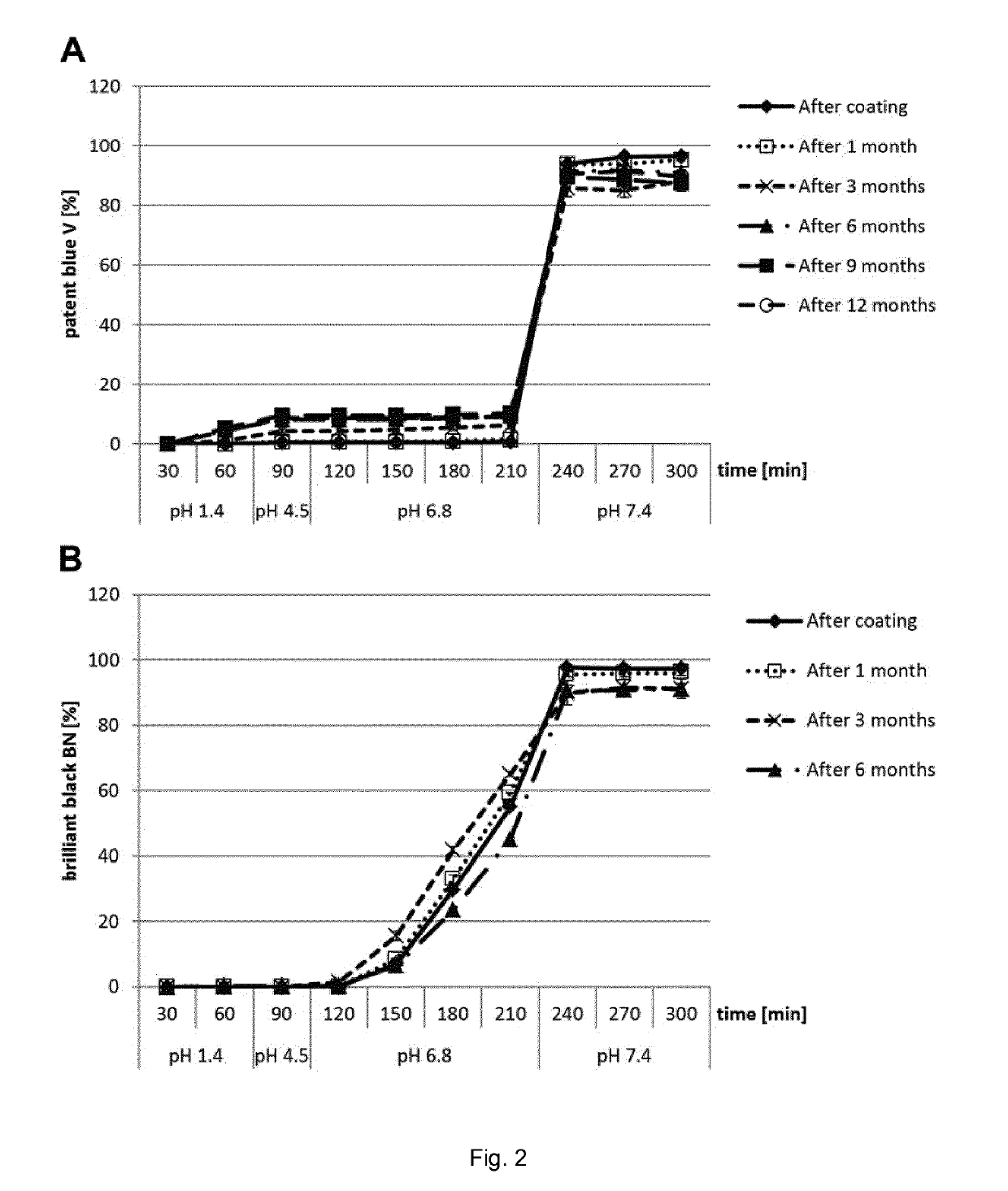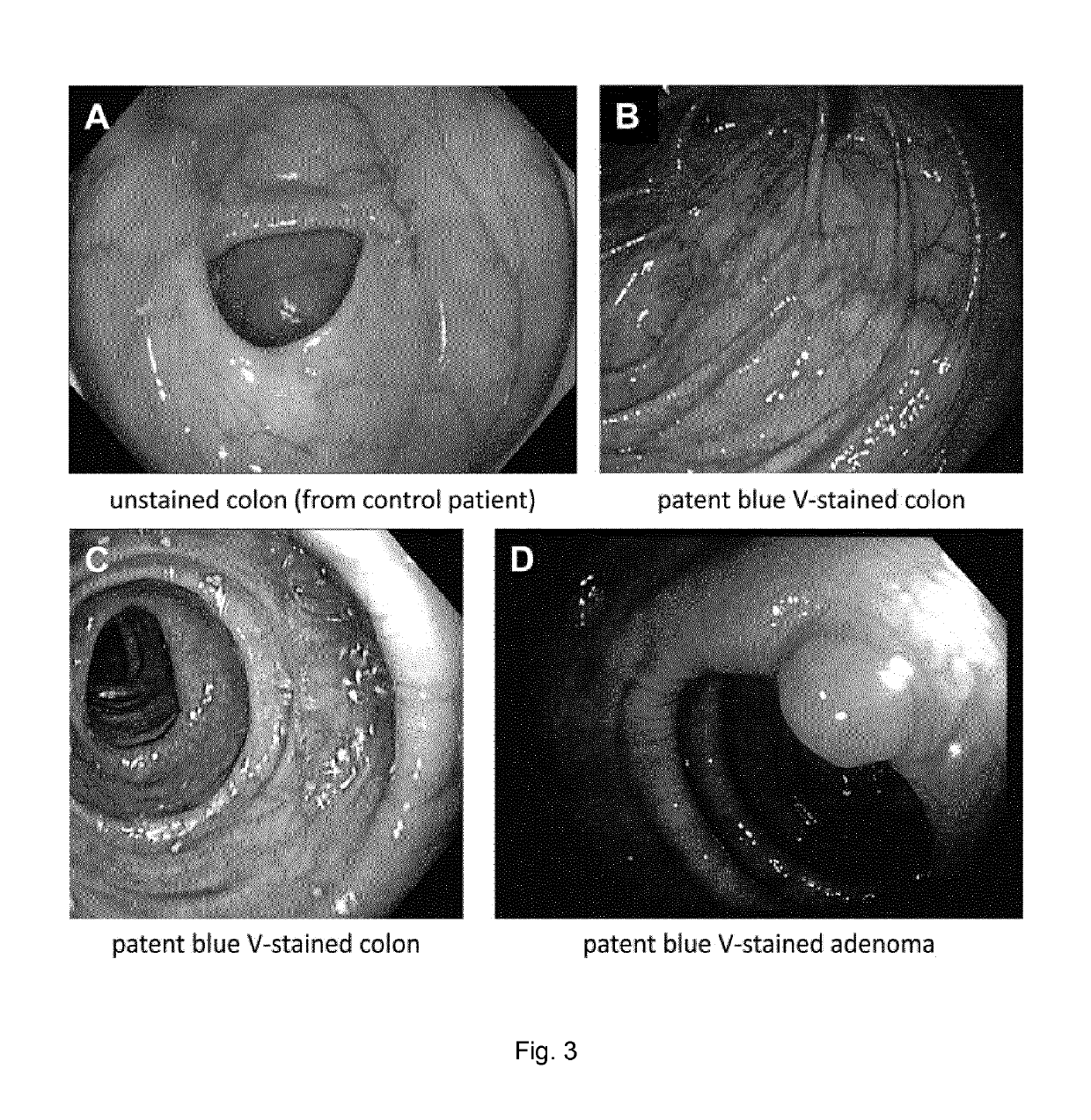Shellac microcapsule formulations and compositions
a shellac and microcapsule technology, applied in the field of shellac microcapsules, can solve the problems of prolonged sustained release profiles for systemic exposure, coating defects, and none of the gras-grade coatings fully complied with the different biological demands of delayed release coating systems, and achieves low production costs and favorable side effect profiles
- Summary
- Abstract
- Description
- Claims
- Application Information
AI Technical Summary
Benefits of technology
Problems solved by technology
Method used
Image
Examples
example 1
n and Characterisation of Dye Microcapsules
[0088]One embodiment of the present invention is that cores comprising the food colours patent blue V and / or brilliant black BN as active substances are coated by two layers of shellac, which are separated by an intermediate layer of a pH-modulating substance (FIG. 1). The use of patent blue V and / or brilliant black BN in the present example served a dual purpose. From a mechanistic point of view, the visible release of these dyes in the targeted parts of the intestine was the proof of principle of the release any active substance according to the broader scope of the invention. At the same time, the example was also required to illustrate the successful use of dye-containing microcapsules for chromoendoscopy of the colon according to one particular embodiment of the invention. In the microcapsules used in this example, nicotinamide was used as a food-grade excipient with stable pH properties (pH 6.61) and previously proven good granulation...
example 2
Man (FIM) Study
Aims of the Study
[0097]In the FIM study, size 0 gelatin capsules filled with well-characterised batches of microcapsules containing patent blue V or brilliant black BN (see Example 1) were administered to outpatients undergoing endoscopy of the gastrointestinal tract. The aims of the study were (1) to investigate whether the in vitro release profiles of the dye microcapsules translated into appropriate in vivo release (general proof of concept for the microcapsules of the present invention) and (2) to analyse the suitability of the dye microcapsules for chromoendoscopy of the colon (special proof of concept for representative food-grade chromoendoscopy dyes as active substances).
[0098]For study aim (2), the primary objective was to demonstrate sufficient staining of the complete colon, and the secondary objective was to indirectly compare possible side effects with the published rates of methylene blue MMX® tablets (Repici et al. 2012, Contemp. Clin. Trials. 33:260). ...
example 3
n of Microcapsules with Methylene Blue and Indigo Carmine
[0134]The techniques described in Example 1 are advantageously used to produce further types of microcapsules comprising other dyes preferred according to the invention, namely methylene blue and indigo carmine. In contrast to the contrast dye indigo carmine, which pools in grooves and crevices after release from the shellac microcapsules, methylene blue is absorbed by the intestinal epithelium, with the advantage that the staining with methylene blue microcapsules is less likely to be compromised by excessive fluid intake.
PUM
| Property | Measurement | Unit |
|---|---|---|
| pH | aaaaa | aaaaa |
| thickness | aaaaa | aaaaa |
| total volume | aaaaa | aaaaa |
Abstract
Description
Claims
Application Information
 Login to View More
Login to View More - R&D
- Intellectual Property
- Life Sciences
- Materials
- Tech Scout
- Unparalleled Data Quality
- Higher Quality Content
- 60% Fewer Hallucinations
Browse by: Latest US Patents, China's latest patents, Technical Efficacy Thesaurus, Application Domain, Technology Topic, Popular Technical Reports.
© 2025 PatSnap. All rights reserved.Legal|Privacy policy|Modern Slavery Act Transparency Statement|Sitemap|About US| Contact US: help@patsnap.com



